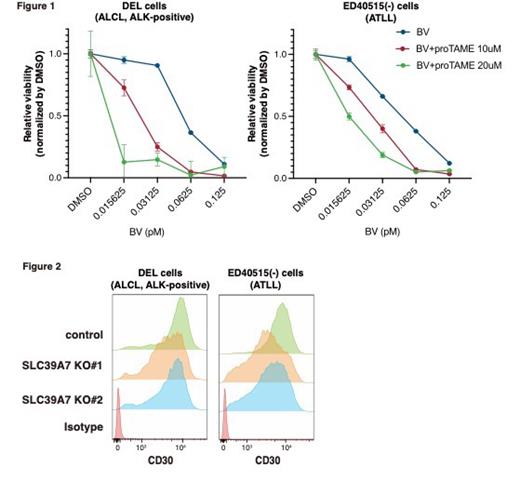Introduction: Brentuximab Vedotin (BV), an antibody-drug conjugate that specifically delivers the potent cytotoxic drug monomethyl auristatin E (MMAE) to CD30-positive cells, has been widely used as one of the key drugs for the treatment of peripheral T-cell lymphomas (PTCLs). BV shows relatively high response rate, however, the prognosis of PTCLs is not still satisfactory. The molecular mechanisms concerning sensitivity to BV remain to be clarified.
Methods: To assess the cell-intrinsic genes affecting susceptibility to BV in PTCL cells, we performed a whole-genome loss-of-function CRISPR screen in DEL, an anaplastic large cell lymphoma (ALCL), ALK-positive cell line. DEL cells were transduced with the Brunello CRISPR knockout pooled library targeting 19,114 genes (4 sgRNAs/gene) followed by puromycin selection. Then, the transduced cells were treated with BV or DMSO control for 6 days. To rank the sgRNAs responsible for BV sensitivity, MAGeCK algorithm was used. Among the top 20 enriched genes, we further selected ones having at least 2 sgRNAs with a log2 fold change (BV/DMSO) < -0.5 or >0.5 as genes whose knock out confer BV sensitivity or resistance, respectively.
Results: Through the whole-genome loss-of-function CRISPR screen, we identified 17 genes or 15 genes whose knock out confer BV sensitivity or resistance, respectively. TNF receptor superfamily member 8 (TNFRSF8, also known as CD30), a known BV target, was ranked as a top gene for BV resistance, confirming the reliability of our screening. Among the 17 enriched genes whose knock out confer BV sensitivity, endogenous mitotic checkpoint complex (MCC) inhibitors, namely MAD2L1BP and ANAPC15 were identified. As a confirmation, we knocked out MAD2L1BP or ANAPC15 in PTCL cell lines by CRISPR and found the enhanced susceptibility to BV of the cells. MAD2L1BP and ANAPC15, the endogenous MCC inhibitors, are known to facilitate anaphase-promoting complex/cyclosome (APC/C) activation. Therefore, we evaluated whether APC/C inhibition sensitize the PTCL cells to BV or not. Importantly, a combination use of proTAME, an APC/C inhibitor, and BV significantly suppressed cell proliferation of multiple PTCL lines, including ALCL, ALK-positive and adult T-cell leukemia/lymphoma (ATLL) (Fig. 1), compared to each single agent. In cell cycle analyses, PTCL lines treated with the combination demonstrated increased percentages of cells in G2/M phase, compared to each single agent. On the other hand, we found SLC39A7, a zinc channel in endoplasmic reticulum (ER), among 15 enriched genes whose knock out confer BV resistance. Since SLC39A7 has been reported to regulate TNFR1 cell surface expression (Fauster et al. Cell Death & Differentiation 2019), we hypothesized SLC39A7 could also affect the CD30 cell surface expression levels. In fact, flow cytometry analyses revealed downmodulation of CD30 cell surface expression in SLC39A7 knocked out PTCL lines (Fig. 2). We further evaluated the amount of CD30 protein expression by immunoblotting and found that SLC39A7 knocked out cells reduced the amount of mature form of CD30, which was consistent with the findings in flow cytometry. Intriguingly, we observed increasement of lower molecular weight band, which was considered as immature precursor CD30, in SLC39A7 knocked out cells, suggesting that impared glycobiology in ER might be a cause for surface CD30 downregulation in SLC39A7 knocked out PTCL cells. Finally, we treated PTCL lines with NVS-ZP7-4, an SLC39A7 inhibitor and the similar results were obtained regarding to CD30 expression by flow cytometry and immunoblotting.
Conclusions: We performed an unbiased genome-wide CRISPR/Cas9 library screen and identified cell-intrinsic regulators for BV sensitivity in PTCLs. Our screening results suggested that the disruption of MAD2L1BP/ANAPC15 or APC/C inhibition would be a potential strategy to enhance therapeutic activity of BV in PTCLs. We also identified SLC39A7 downregulation could confer BV resistance by downregulating CD30 cell surface expression.
Disclosures
Goto:SymBio: Research Funding; Bristol-Myers Squibb: Research Funding; Novartis: Honoraria; Chugai: Honoraria; Kyowa Kirin: Honoraria, Research Funding. Teshima:Fuji Pharma: Research Funding; Chugai: Honoraria, Research Funding; Kyowa Kirin: Honoraria, Research Funding; NIPPON SHINYAKU: Honoraria, Research Funding; Asahi Kasei Pharma: Membership on an entity's Board of Directors or advisory committees, Research Funding; Eisai: Research Funding; Celgene: Honoraria, Membership on an entity's Board of Directors or advisory committees; Janssen: Honoraria, Membership on an entity's Board of Directors or advisory committees; Meiji Seika Pharma: Membership on an entity's Board of Directors or advisory committees; Merck Sharp & Dohme: Honoraria; AbbVie: Honoraria; Novartis: Honoraria, Membership on an entity's Board of Directors or advisory committees; Bristol-Myers Squibb: Honoraria; DAIICHI SANKYO: Membership on an entity's Board of Directors or advisory committees; AstraZeneca: Membership on an entity's Board of Directors or advisory committees; LUCA Science: Research Funding; Otsuka: Research Funding; Priothera SAS: Research Funding; Takeda: Membership on an entity's Board of Directors or advisory committees; Roche Diagnostics: Membership on an entity's Board of Directors or advisory committees; Astellas: Honoraria, Membership on an entity's Board of Directors or advisory committees, Research Funding; SHIONOGI: Research Funding; ONO: Research Funding; Sanofi: Membership on an entity's Board of Directors or advisory committees; Sumitomo Pharma: Honoraria, Membership on an entity's Board of Directors or advisory committees, Research Funding. Nakagawa:AbbVie Inc.: Research Funding; Meiji Seika pharma: Honoraria; Astrazeneca: Honoraria; Mundipharma: Honoraria; Takeda Pharmaceutical Company Limited: Honoraria, Research Funding.


This feature is available to Subscribers Only
Sign In or Create an Account Close Modal